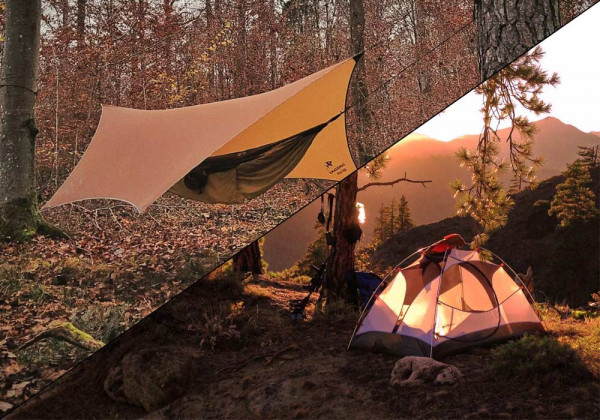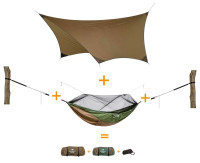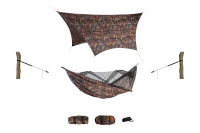Hammock with tarp or a tent for an overnight stay outdoors? Both sleeping options have their advantages and disadvantages.
Hammock setup - 10 advantages over the tent:
1. Wild camping with a hammock is not forbidden
Wild camping with a hammock or tarp is tolerated in Germany, whereas wild camping, with a few exceptions, is prohibited.
2. Weight and volume lower with hammock
Our ADVENTURE SET made of ultra-light ripstop material weighs only 940g including mosquito hammock, suspension ropes and tarp. When packed, the individual parts have a volume of 3 drink cans. This means you can easily store them in your backpack. A standard tent often weighs more than 1kg and is a little bulkier when stowed in a rucksack.
3. No condensation under the tarp
Unlike a tent (especially a single-layer tent), where condensation can form on the walls from breathing, there's always plenty of air circulation in a hammock.
4. Sleeping comfort is higher in hammocks
You can lie more comfortably in a hammock than on the ground in a tent. If you use the Brazilian lying technique, you can even sleep with your back stretched out and be gently rocked to sleep.
5. In a hammock you are part of nature and protect it at the same time
In a hammock you can enjoy your surroundings more directly. You can not only look at the starry sky, but also immediately see where an unknown noise comes from. Hammocks protect nature. The ground is not used over a wide area as it is with a tent. This means that small creeping animals and plants are spared.
6. Hammocks offer protection from animals, thanks to the mosquito net and the distance from the ground
Crawling animals such as ants and snails cannot harm you in a hammock. In a hammock with a mosquito net you are also safe from mosquitoes. You are even protected from relatively large animals, such as wild bears, if you hang your hammock relatively high.
Most hammocks and tarps are made in muted colours or a camouflage pattern. This is less noticeable in the wild than a brightly coloured tent. This can look like a foreign object to animals, which could make them aggressive.
7. Hammocks are better on damp and uneven ground
You can set up a hammock over damp and uneven ground, as well as on slopes where you usually have a great view of the area.
You don't necessarily need trees to use a hammock or tarp. You can also set it up on the ground using trekking poles, branches or rocks.
8. With a tarp you can try different setups
A hammock setup offers many different ways to set up your tarp. Close to the ground as a tent substitute, sheltered from the wind or open to enjoy the view or create space for several people.
9. Rain-protected living space under a tarp
When it rains, you can prepare food under a tarp, sit with several people or even build a campfire.
10. Winter suitability of the tarp, thanks to a slanted setup
Most tents are not designed for heavy snowfall. The tent poles could buckle under the weight of the snow. A tarp, on the other hand, can be pitched at an angle so that the snow slides down.
What other equipment you need for an overnight stay in a hammock.




